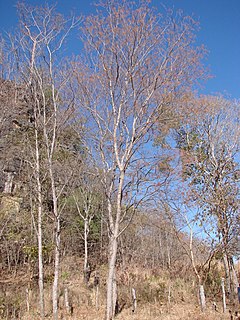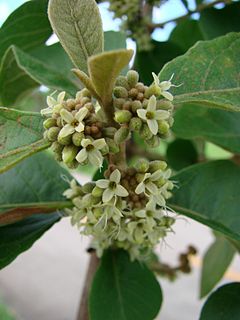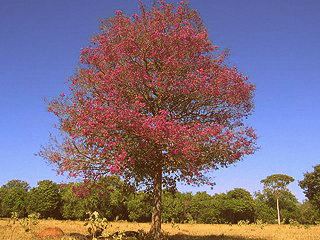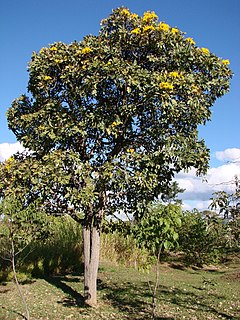
Araucariaceae – also known as araucarians – is a very ancient family of coniferous trees. The family achieved its maximum diversity during the Jurassic and Cretaceous periods, when it was distributed almost worldwide. Most of the Araucariaceae in the Northern Hemisphere vanished in the Cretaceous–Paleogene extinction event, and they are now largely confined to the Southern Hemisphere, except for a few species of Agathis in Southeast Asia.

Hevea is a genus of flowering plants in the spurge family, Euphorbiaceae, with about ten members. It is also one of many names used commercially for the wood of the most economically important rubber tree, H. brasiliensis. The genus is native to tropical South America but is widely cultivated in other tropical countries and naturalized in several of them. It was first described in 1775.

Schinopsis is a genus of South American trees in the family Anacardiaceae, also known by the common names quebracho, quebracho colorado and red quebracho. In Brazil it is known as baraúna or braúna.

The giant otter or giant river otter (Pteronura brasiliensis) is a South American carnivorous mammal. It is the longest member of the weasel family, Mustelidae, a globally successful group of predators, reaching up to 1.7 metres (5.6 ft). Atypical of mustelids, the giant otter is a social species, with family groups typically supporting three to eight members. The groups are centered on a dominant breeding pair and are extremely cohesive and cooperative. Although generally peaceful, the species is territorial, and aggression has been observed between groups. The giant otter is diurnal, being active exclusively during daylight hours. It is the noisiest otter species, and distinct vocalizations have been documented that indicate alarm, aggression, and reassurance.

Malus sieversii is a wild apple native to the mountains of Central Asia in southern Kazakhstan. It has recently been shown to be the primary ancestor of most cultivars of the domesticated apple. It was first described in 1833 by Carl Friedrich von Ledebour, a German naturalist who saw them growing in the Altai Mountains.

Myracrodruon urundeuva is a timber tree, which is often used for beekeeping. This plant is native from Argentina, Brazil, Bolivia and Paraguay, and it is typical of Caatinga, Cerrado, and Pantanal vegetation in Brazil.
Aegiphila mollis is a species of flowering plant in the family Lamiaceae. It is native to Central and South America. Its common names include contra culebra and totumillo.

Aegiphila lhotskiana is a species of flowering plant in the family Lamiaceae. It is native to South America, where it occurs in Bolivia and Brazil. This species is cited in Flora Brasiliensis by Carl Friedrich Philipp von Martius.

Aegiphila is a genus of flowering plants in the mint family, Lamiaceae, first described in 1763. It was formerly classified in the Verbenaceae. It is native to Mexico, Central America, South America, the West Indies, and Florida.

Aniba rosaeodora, also known as pau-rosa, is a species of Magnoliid tree in the family Lauraceae. Although sometimes wrongly referred to as rosewood this name is totally misleading; it is no tree of the genus Dalbergia. It grows in parts of the tropical rainforest of South America. It is an endangered species that sees exploitation for its essential oil.

Roupala is a Neotropical genus of woody shrubs and trees in the plant family Proteaceae. Its 34 species are generally found in forests from sea level to 4000 m altitude from Mexico to Argentina.

Tabebuia aurea is a species of Tabebuia native to South America in Suriname, Brazil, eastern Bolivia, Peru, Paraguay, and northern Argentina. The common English name Caribbean trumpet tree is misleading, as it is not native to the Caribbean. It is also known as the silver trumpet tree, and tree of gold.

Guaporé Biological Reserve (Portuguese: Reserva Biológica do Guaporé is a biological reserve in the state of Rondônia, Brazil, on the border with Bolivia.

Dipteryx alata is a large, undomesticated, edible nut-bearing tree from dryish tropical lowlands in central South America belonging to the legume family, Fabaceae, from the Dipterygeae tribe in the Faboideae subfamily. It is a wild species, widespread across the Cerrado savanna in South America.

Schinopsis brasiliensis is a species of flowering plant in the cashew family known by the common names baraúna or braúna.

Attalea phalerata is a species of palm tree known by the English common name urucuri palm, the Portuguese common name urucurizeiro, and the Spanish common name shapaja. Other common names include motacu and bacuri. It is native to Brazil, Bolivia, Paraguay, and Peru, where it grows along southern and western Amazonia. It is the most common palm tree on the Pantanal.
Hollandaea is a genus of four species known to science, of Australian rainforest trees, constituting part of the plant family Proteaceae.

The Jataí Ecological Station is an ecological station (ESEC) in the state of São Paulo, Brazil. It protects an area of cerrado and a lagoon system that is important for fish breeding.














